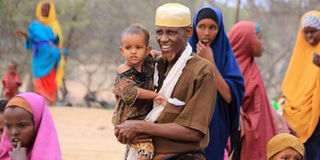Hopelessness among many as Dadaab shuts

Refugees wait to undergo a documentation process at Dadaab airstrip on June 16, 2016 as they prepare to be voluntary repatriated. PHOTO | JEFF ANGOTE | NATION MEDIA GROUP
What you need to know:
- Abdiaziz Shafee, a second-year diploma student at Mount Kenya University (MKU)
- He has to face the reality that he might not be going back to school after all, and that his dream of completing his education might be no more.
When 25-year-old Abdiaziz Shafee closed college in April and went home for the holidays, he had no reason to think he might not go back when schools reopened to continue with his studies.
But now, the second-year diploma student at Mount Kenya University (MKU) has to face the reality that he might not be going back to school after all, and that his dream of completing his education might be no more.
Shafee is a refugee, born in Liboi, the border town of Kenya and Somalia, in 1991, when his family was fleeing the civil war in Somalia.
He is among thousands of his generation born at the camps to parents whose lives were shattered by the political upheavals in Somalia.
And now, he too, has brought forth children into this uncertain life, perpetuating a vicious cycle of statelessness.
He has never set foot in Somalia, the bulk of his life having been lived in Hagadera camp in Dadaab.
He believed that education was his ticket out of the narrow, opportunity-poor life that a refugee could expect. But recent events are teaching him painfully just how little say he has in the course his life takes.
“I was all set to finish my diploma in Public Relations this year and enrol for a degree immediately. But those dreams will remain just dreams,” he said.
He was awarded a scholarship by the European Union for being among the best students at his Waberi Secondary School in the 2011 Form Four exams, having scored C+.
The reason Shafee is unable to return to MKU six weeks after classes started is that he is unable to get the movement pass to travel to his college in Thika. This is as a result of government having dissolved the Department of Refugee Affairs(DRA).
In the absence of the DRA, there is little that the United Nations High Commission for Refugees can do to help him. His future hangs in a balance.
For Shafee, this is just one more rejection, a painful reminder that he is living on borrowed time in a country that has declared its stand on people like him.
“I have been a refugee my entire life and I can tell you that this is the lowest position in life. The Kenyan government wants us to go back to Somalia but that is a Somalia that I have never even set eyes on, he says.
Shafee is worried even more for his children, two toddlers, whose future is even more uncertain than his.
“At least I got an education in Kenya, no matter how basic. But my boys, who are yet to start school, will have to grow up in a Somalia that is so unstable, they may never go to school,” he says.
Like most refugees, he has dreams of being resettled in third countries like the United States or Canada. In 2012, he did a resettlement interview, but nothing came out of it.
On the other hand, the process to repatriate willing refugees is a picture of efficiency, one that takes just a week.
But he is unwilling to cast his lot on the latter and has decided to stay on until the last possible minute, praying for a miracle to happen.
But doesn’t Somalia need educated young men like him to restart its economic engines?
“I would very much like to work in Somalia and help in the rebuilding of our country but the opportunities don’t exist. I have friends who have gone back and they tell me that it is very difficult to get jobs because the Somali government is shunning those with Kenyan certificates,” he says.
Shafee paints a bleak picture of a disenfranchised group of people who face an impossible decision come the closure of the camp.





